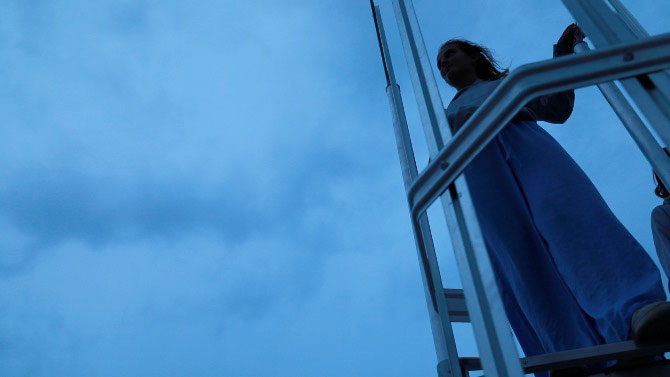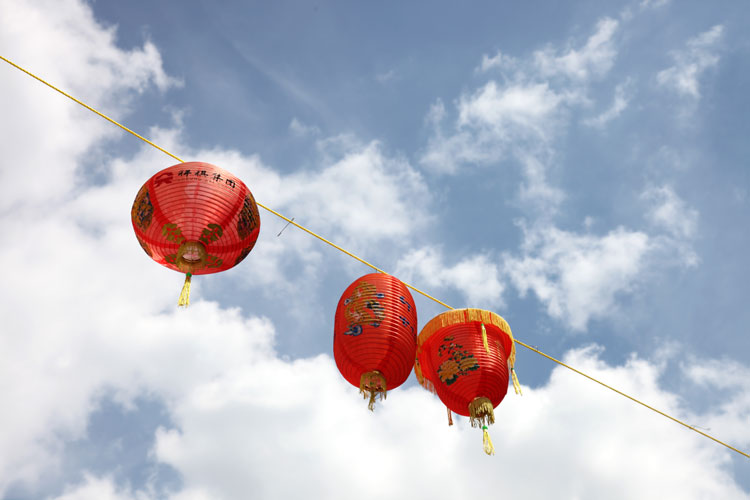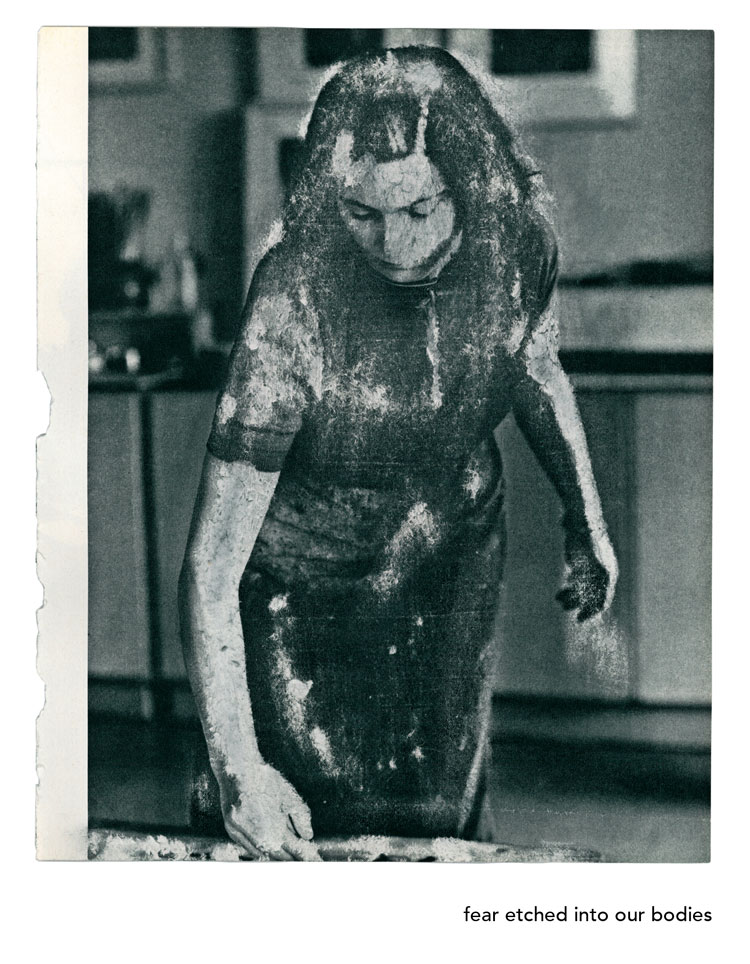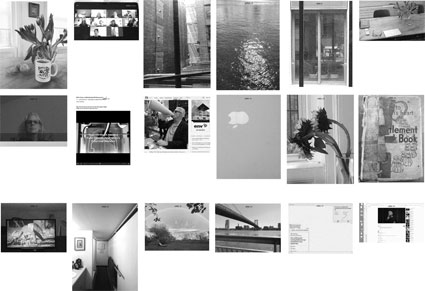
Natacha Nisic. Photo © Tim Trompeter.
by NICOLA HOMER
The world of art has changed. Museums are forced to innovate in the pandemic. The Frick Collection in New York has launched a YouTube series, snappily called Cocktails with a Curator. A parallel can be seen in how artists are playing at being curators, as they create new digital spaces. One example is The Crown Letter, launched in April by the French artist and film-maker Natacha Nisic.
The artist held a solo exhibition, Écho, at the Jeu de Paume in Paris in 2014, with a focus on the Fukushima earthquake of 2011. In an accompanying video, she spoke of the defining events of her generation: the collapse of the Berlin Wall and the civil war in the former Yugoslavia. Nisic said: “Disappearance is a crucial theme of my work.” In counterpoint, she offers visibility to female artists with her participatory art project.
The Crown Letter is an online platform that hosts about 40 female artists, scattered across the world, from Europe to Japan to South America. The digital project, which started at the beginning of April, has been quietly growing in recent months. The collective has assembled more than 200 works to date. Now, Slash magazine, published on the Slash-Paris website, is hosting the platform every month for a year, bringing the artists to an even wider audience.

Esther Shalev-Gerz, Auciel, photography, 2020.
While speaking from her home in France, Nisic selected some interesting works from The Crown Letter. One highlight is Esther Shalev-Gerz’s photography of a deserted street in her neighbourhood in Paris, within the realm of a 1km (0.6 mile) walk, which city dwellers were allowed to take during the lockdown in the spring. The artist captures moments of an encounter with a homeless person through a picture-poem, Auciel.
Nisic talked about the Chilean-born Argentinian artist Catalina Swinburn’s video of hands folding paper, where gestures create a metaphor for the conversations of the group. And she drew attention to Luise Schröder’s collages from archives, where she captured particular moments of the lockdown by using historical gaps to reflect contemporary experiences, while living and working in Potsdam, near Berlin.

Catalina Swinburn, the music is not in the notes, but in the silence between, video, 3 min 57 sec. 2020.
The Polyphonic Manifesto is a unifying element, where artists have joined the global chorus against racial injustice in the United States. This involved The Crown Letter publishing text-based works, as a response to the murder of George Floyd in Minneapolis, on 25 May this year, a historic moment that resulted in international headlines comparable to those in the case of Emmett Till, whose murder was an important catalyst for the American civil rights movement.
Studio International spoke by phone to Nisic at her home in Paris. The following is an edited extract from that interview:
Nicola Homer: Could you tell me a little bit about your own story as an artist and the influences on your career?
Natacha Nisic: I’m a visual artist, making films and installations. I have been doing a lot of work related to the notion of catastrophe. Mostly, I’ve made works in Japan, where I’ve been working on the idea of a strategy of survival. I created an important installation, e (2009), about a huge earthquake, at the same latitude as Fukushima, but which was in the mountains. I also did many works about the Holocaust and the questions of testimonies. When the Coronavirus crisis appeared, I had the strange feeling that what I had studied was now taking place before my eyes. Without any further distance from the event, forced to experience it live, I had to find other ways to understand it.
NH: That is fascinating. It sounds as if you have addressed issues of catastrophe before. How do you think that led to your founding this initiative, The Crown Letter?
NN: It is not something I planned. I was following the pandemic from the European point of view, coming from the Chinese, and then it went to Italy and to France. I had in mind the things I had studied about what people were saying, before something important happens. Then it was here, and the lockdown had been imposed. I did a film about the biography of Aby Warburg, a German art historian at the time of the First World War, Rather Die Than Die (2018). I looked at this position of being someone who observes and tries to make an archive of what is happening at that very moment. That was a way to understand, but also to ward off fear and panic. I had the feeling I was in this position.
As the lockdown arrived, it was evident that we were all in our houses with nothing other than information elements such as the internet or the TV to understand what was happening. Soon, I thought: “Oh, I’m so passive. I miss my friends. I miss what has been important in my own career: travel and other artists’ practices.” I realised that we must find a place for that because it is going to be like we are in a mental prison, not being able to share in a physical sense. The museums are going to be closed, so where do we meet again? Where do we share our personal views and experiences? What would bring us a form of visibility? What is the public space now? So, those were important questions.

Natacha Nisic, Malakoff, video, 54 sec.
NH: This appears to be a collaborative art project, where you have nurtured an exhibition space for female artists across the world. Why did you create this space, particularly for female artists on a global platform?
NN: I was certain that it would be huge chaos. I didn’t like the way that museums use the internet. I did not find it very creative. So, I thought it should be made by artists. We have to take the power back in this internet age. We have to make our own visible place to be. So, that was my first aim.
In the history of women, the home is the place where a woman has had to be. There is a link between the home, the studio and the room with a view. With everyday life in lockdown, I wished to invent a place somewhere else, where we could put everything we had to say. So, it’s one reason why I began this internet project.
So, there was the idea of creating an observatory of our situation, and also an archive of the time, because it’s a weekly release. The Crown Letter began to be a collection. Now, after four months, we have more than 200 works. So, I thought: “Wow, it’s like the process where different levels of sediment create a landscape."

Ruth Maclennan, Cornhill, video, 3 min 51 sec.
NH: That is a lovely process of building layers. So, you have collected more than 200 works. Could you talk through some of your favourites?
NN: Oh, it’s very difficult. I can’t say there is one work that I like, because it’s not true. It’s about how the artists took The Crown Letter and used it as their own tool. For example, Ruth Maclennan decided from the beginning to do new videos, far away from her usual practice, where she travels and makes long films. Ana Mendes tries to find the right minimalist gesture. Luise Schröder from Germany, posts a new image every week, which is a collage made from historical elements: if you read what she has done from the beginning, you can draw a history of our time of lockdown. Or consider Katja Stuke, who said: “I’ll go back into my archive when I was working in Tokyo.” She takes things from an old personal archive and gives them life through The Crown Letter. It is not nostalgia for the time before the crisis, but is pointing out how things that were already there, are now central and sound so accurate. It’s exciting to see how everyone considers what to propose, and how it will help you in this situation to go into your own practice.

Luise Schröder, fear etched into our bodies, collage, 2020.
NH: It is good to hear you highlight some of the different ways in which artists involved have been engaging with the project.
NN: Yes. There was something very interesting during the lockdown. After one month, Anne Dubos had twins. She is an anthropologist and an artist, and she could not write a lot as she was in a very difficult situation because of the crisis in hospitals. She had to face fear and solitude for months. But she managed to send us simple little fragments of her situation. It was so touching because I had the feeling that The Crown Letter was building a solidarity, a circle of women talking to each other. It was an artistic way for her to express her experience.

Anne Dubos, Gestures, 2020.
NH: That is a lovely example. I am also interested to hear about the artists in Japan.
NN: At the beginning, I wrote to Mika Shigemori, an expert in playing the shamisen (a three-stringed, traditional Japanese instrument), who works with contemporary artists. I asked her to collaborate, and she sent us videos. So, I found it interesting to have musical elements in The Crown Letter, performative things. Another artist is Mutsumi Tsuda, who said: “I’m in a lockdown. In my garden, there are bamboos growing up. Many of them. But in a few months, during the autumn, lots are going to die. So, I’ve made photographs of those.” So, she did that from the beginning. In a regular way, she makes photographs of those garden things with the idea that they might die. It is very interesting to see the relation between Japanese artists based in Japan and Japanese artists, such as Kyoko Kasuya, who lives in Paris, how nature and city are central in their works.

Mutsumi Tsuda, photography, 2020.
NH: Yes, I can see that the way Tsuda looks at nature is touching.
NN: In the first week, Tsuda wrote lines for the project. From the beginning, I contacted about 40 artists, all friends whom I had met during my career. But there are geographical parts of the world that are missing. I would like to gradually welcome artists from Australia or Africa. It is how things build up in a singular way.
NH: I understand that it is challenging with a project of this nature to cover everything. You can only select interesting works. For example, I liked Maclennan’s work Cornhill, which is a poetic evocation of London.
NN: Yes. That’s beautiful. And did you see Esther Shalev-Gerz, who has been photographing the street where she lives in Paris, where this homeless guy has made a strange monument? During the lockdown this spring, the streets were empty in Paris, and she began to talk to him. We talked about this when we met as a virtual community in The Crown Salon. This was maybe the only dialogue she had during this lockdown, when Paris was an empty city, which is very touching. Liza Dimbleby, Michelle Deignan and SE Barnet also have poetic relationships to public and intimate space.
NH: In our conversation about The Crown Letter, we have highlighted how some of the artists’ works look at different geographical locations, and environmental and social issues. Can you talk about examples of diversity in this project?
NN: Yes, I can mention some Argentinian artists who are contributing, Adriana Bustos, Ivana Vollaro and Catalina Swinburn. At the beginning of the lockdown, Swinburn was in the countryside. So, she proposed some work she had already done. The first video she posted is powerful, where you can see her hands, folding paper to make a large dress. She explained to us that all those gestures of folding paper manually were like the conversations we all had together. We were creating this virtual community with our weekly meetings of The Crown Salon. We were the community that she couldn’t have in reality. I understood that The Crown Letter appeared and continues because of the lockdown, but mainly because we were waiting for such a place to exist.
NH: That is nice. Could you tell me about the artist Andrea Blum in New York and how she captured the political situation?
NN: Yes. At the beginning of the lockdown earlier this year, she made a diary in her own district, making use of photography of her everyday life, sending it to us every one or two weeks. The situation turned out badly in New York because of the death toll and the crisis. After a certain time, the US political situation took such a bad turn that she said: “I am falling into a deep depression. I cannot work any more. So, I will send you my last work with my last letter.” It’s on our website.

Andrea Blum, Corona Diary, 2020.
NH: I can see that in one of Blum’s last entries, she talks about the death of the African American man George Floyd, which led to protests over racial injustices.
NN: Actually, there is a special release called The Polyphonic Manifesto (crownproject.art/manifesto). It’s from a particular week, this time when the Black Lives Matter movement happened in the US. We decided to bring our own voices, expressing our solidarity with it. We decided not to post any imagery or video, but just text: black-and-white letters we sent at that time.
NH: It is interesting to hear about how the project works. I see you have included a number of artists, as well as key elements, such as this manifesto.
NN: Yes, we have the weekly release on the internet, but we all meet for conversations every week in The Crown Salon. Maclennan has organised this from the beginning. It was her initiative – it’s brilliant. No one knew each other at first. Through our conversations, everyone began to meet. It’s reactive as we’re talking about female artists’ views, personal issues, geographical and political situations. These are very nice moments: very friendly, very open, very free. When we decide on something that we think is a common reflection, we can be very fast, as seen in The Polyphonic Manifesto. It’s one quality of the project, that it’s a long-term project, but it’s also very reactive to anything we want to express.
NH: That’s great. It sounds like a very nurturing project space.
NN: Yes, it is. Something nice about the project is that there are not only artists, but also composers and writers in The Crown Letter. There is one writer, Anne Brunswic, a rather well-known writer in France, who said: “I wouldn’t usually be able to do regular little letters or novels, no publishing house would do it. So, I can send a new little thing every week. There is a presence in that.” So, that is one function of The Crown Letter. It’s permitting unusual things for everyone.
NH: Yes. Absolutely. That is a mingling of different art forms.
NN: There is a contemporary music composer, Chiyoko Szlavnics, who has produced visual artworks, which are rather different from her own personal compositions, for The Crown Letter. So, it’s very interesting to see how this platform is challenging us to invent something new.
NH: I agree. I am wondering if perhaps this initiative is helping to explore new forms of innovation. Do you think this way of working could be something that is worth investing in for the future?
NN: I think so. It’s my first time doing a website. I learned how to do it with a tutorial. So, I’m exploring this new medium. In the lockdown, everyone has to work with the internet and do Zoom sessions. Offices have to do homeworking. But what we have managed is different, as it’s a very friendly, non-hierarchical thing, totally open, which has many possibilities. It gives us an impulse to create and talk every week, it works as an echo chamber to our personal reflection. We have to adapt ourselves, to react, to move from our usual artistic tracks. So, it’s very innovative. We needed a place for free expression, a visibility, a female presence. Now, it has been moving into exploring media, it has a lot of perspective.
NH: That is most interesting. This innovative way of working on this platform sounds valuable. Can you identify any elements worth investing in?
NN: There is something visible and invisible in The Crown Letter. What is visible is the newsletter you receive. What is invisible are the conversations in The Crown Salon, which are very important. From that, we are generating new projects, we are sharing artistic practices. This invisible part is only possible because of the internet. We’re inventing something in this field, which seems normal now. But we have also invented a way to talk to each other, which I had never had before.
NH: It sounds as if it is facilitating communication among artists across the world.
NN: What is interesting is there is no mediation. Usually, when you see things organised by an institution, such as a museum, it’s coming from the institution, which invites people for a virtual conversation. But we are doing something totally different. We’re doing our own conversation. No one is leading us; we are our own leaders. It’s invisible. It’s for us. And from that, we are doing something else, which is going to be visible on the internet.
NH: That is a valuable point that you make about mediation. The Crown Letter appears quite fresh in how it presents artists’ voices directly.
NN: Yes. I made a little joke at the beginning. I said, we have to learn the new tools of our practice. None of us knew how to use the internet very well. Now, everyone is a website administrator. First, we had to learn our new tools of expression. Second, it’s totally horizontal, we make decisions in a collective way. There is no top-down organisation. That is because we are already suffering a lot in this lockdown, personally and institutionally. We need to create places where there is a sense of freedom, the possibility for self-expression and to be listened to by people.
NH: I can see that it is a space for freedom of expression among female artists that is important. What are your hopes for the future with this project?
NN: We have a little money for a sustainable project, as some of us are applying for a little grant so we can continue. We may be invited to have an exhibition at a biennale. If in one year’s time, there is a possibility to show The Crown Letter in a real place, do we do it? It’s one of the challenges ahead. The question is: will we meet in real life as we know each other through our screens? And we must ask whether there is a purpose for that, because of the climate crisis.
NH: Yes, that is an interesting dimension. I would like to talk about visual art and the gender gap. I’m aware there is inequality in the art world. Many female artists go to art school, but it’s often male artists who make the successful transition to having exhibitions at big institutions. Challenges may be emphasised at this time of lockdown. How do you think this project helps to face inequality in the art world?
NN: We’re not a big institution. We are small. But still there is a presence, there is a lot of energy coming from it. We’re present as an international, very strong group. You know, there is a danger of being totally lost at this odd time of lockdown. Of course, because of this gender gap, we have less visibility, we are going to have to fight a lot more. There will be a history of our presence from the beginning of the lockdown. So, it’s going to help us to build something in the future. Or it could help through examples of our work. Other groups might take inspiration to do something else for themselves. But I hope it’s a little seed for something that might grow.
NH: Would you like to sum up what inspired you to do this project, and why you think it’s important?
NN: I thought we were going through a historical moment and we would lose visibility, and all the rules at stake in the art world were going to change. So, that is something that was very clear for me from the beginning: that we would suffer as female artists from this new situation. Also, because it was already very bad for people. We had to be very strong and work fast, to be able to react, to find our places in this new strange world.
NH: Indeed, it sounds as if it is important because it offers a virtual space for female artists to have their voices heard, for freedom of expression.
NN: Yes, it’s true, really true.
• Those who have participated in The Crown Letter since 21 April 2020 are: SE Barnet, Alisa Berger, Kate Blacker, Andrea Blum, Anne Brunswic, Adriana Bustos, Claire Chevrier, Pascale Criton, Hagar Cygler, Michelle Deignan, Silvana Deluigi, Liza Dimbleby, Jutta Doberstein, Anne Dubos, Dettie Flynn, Shani Ha, Julieta Hanono, Claire-Jeanne Jézéquel, Kyoko Kasuya, Aylin Leclaire, Joanna Lombard, Ruth Maclennan, Ana Mendes, Maricarmen Merino, Aurelia Mihai, Doriane Molay, Manuela Morgaine, Tania Mouraud, Natacha Nisic, Kumjana Novakova, Sudha Padmaja Francis, Emmanuelle Pellegrini, Piyarat Piyapongwiwat, Catherine Radosa, Sandra Richard, Esther Shalev-Gerz, Mika Shigemori, Katja Stuke, Catalina Swinburn, Chiyoko Szlavnics, Mutsumi Tsuda, Ivana Vollaro, Jane Watt, Emma Woffenden and Ruth Zylberman.